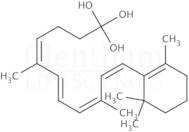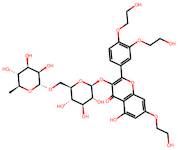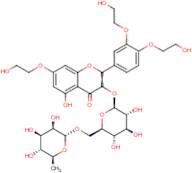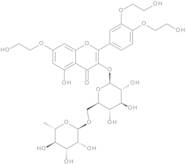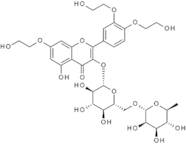CAS 7085-55-4: Troxérutine
Description :Troxérutine, avec le numéro CAS 7085-55-4, est un composé flavonoïde dérivé de la famille de la rutine, principalement connu pour ses propriétés antioxydantes et anti-inflammatoires. C'est un dérivé semi-synthétique de la rutine, qui améliore sa biodisponibilité et ses effets thérapeutiques. Troxérutine est couramment utilisé dans le traitement de l'insuffisance veineuse et des conditions connexes en raison de sa capacité à améliorer la microcirculation et à renforcer les parois capillaires. Le composé présente une gamme d'activités pharmacologiques, y compris des effets anti-œdémateux, qui aident à réduire le gonflement et à améliorer le flux sanguin. De plus, il a été étudié pour ses effets neuroprotecteurs potentiels et son rôle dans la gestion du stress oxydatif. Troxérutine est généralement administré sous forme orale ou topique, et son profil de sécurité est généralement favorable, avec peu d'effets secondaires rapportés. Sa solubilité dans l'eau est modérée, ce qui influence son absorption et son efficacité dans diverses formulations. Dans l'ensemble, Troxérutine est reconnu pour ses effets bénéfiques sur la santé vasculaire et ses applications potentielles dans divers domaines thérapeutiques.
Formule :C33H42O19
InChI :InChI=1S/C33H42O19/c1-14-23(38)26(41)28(43)32(49-14)48-13-21-24(39)27(42)29(44)33(51-21)52-31-25(40)22-17(37)11-16(45-7-4-34)12-20(22)50-30(31)15-2-3-18(46-8-5-35)19(10-15)47-9-6-36/h2-3,10-12,14,21,23-24,26-29,32-39,41-44H,4-9,13H2,1H3/t14-,21+,23-,24+,26+,27-,28+,29+,32+,33-/m0/s1
Code InChI :InChIKey=IYVFNTXFRYQLRP-VVSTWUKXSA-N
SMILES :O=C1C(OC2OC(COC3OC(C)C(O)C(O)C3O)C(O)C(O)C2O)=C(OC4=CC(OCCO)=CC(O)=C14)C=5C=CC(OCCO)=C(OCCO)C5
- Synonymes :
- 2-[3,4-Bis(2-hydroxyethoxy)phenyl]-3-[[6-O-(6-deoxy-α-<span class="text-smallcaps">L</smallcap>-mannopyranosyl)-β-<smallcap>D</span>-glucopyranosyl]oxy]-5-hydroxy-7-(2-hydroxyethoxy)-4H-1-benzopyran-4-one
- 2-[3,4-bis(2-hydroxyethoxy)phenyl]-5-hydroxy-7-(2-hydroxyethoxy)-4-oxo-4H-chromen-3-yl 6-O-(6-deoxy-alpha-L-mannopyranosyl)-D-glucopyranoside
- 2-[3,4-bis(2-hydroxyethoxy)phenyl]-5-hydroxy-7-(2-hydroxyethoxy)-4-oxo-4H-chromen-3-yl 6-O-(6-deoxy-alpha-L-mannopyranosyl)-beta-D-glucopyranoside
- 2-[3,4-bis(2-hydroxyethoxy)phenyl]-5-hydroxy-7-(2-hydroxyethoxy)-4-oxo-4H-chromen-3-yl 6-O-(6-deoxyhexopyranosyl)hexopyranoside
- 3',4',7-Tris[O-(2-hydroxyethyl)]rutin
- 3,5-Dihydroxy-3′,4′,7-tris(2-hydroxyethoxy)flavone 3-rutinoside
- 3′,4′,7-Tri-O-(β-hydroxyethyl)rutoside
- 3′,4′,7-Tris(hydroxyethyl)rutin
- 4H-1-Benzopyran-4-one, 2-[3,4-bis(2-hydroxyethoxy)phenyl]-3-[[6-O-(6-deoxy-α-<span class="text-smallcaps">L</smallcap>-mannopyranosyl)-β-<smallcap>D</span>-glucopyranosyl]oxy]-5-hydroxy-7-(2-hydroxyethoxy)-
- Factor P-Zyma
- Voir d'autres synonymes
- Flavone, 3,5-dihydroxy-3′,4′,7-tris(2-hydroxyethoxy)-, 3-[6-O-(6-deoxy-α-<span class="text-smallcaps">L</smallcap>-mannopyranosyl)-β-<smallcap>D</span>-glucopyranoside]
- Posorutin
- Rufen-P4
- Ruven
- Toxerutin
- TriHER
- Trihydroxylrutin
- Trioxyethylrutin
- Tris(hydroxyethyl)rutin
- Tris(hydroxyethyl)rutoside
- Tris-O-(2-hydroxyethyl)rutin
- Tris-O-(β-hydroxyethyl)rutoside
- Troxerutin
- Troxerutine
- Troxevazin
- Vastribil
- Veinamitol
- Veniten
- Venoruton P<sub>4</sub>
- Vitamin P<sub>4</sub>
- Z 6000
- 2-[3,4-Bis(2-hydroxyethoxy)phenyl]-3-[[6-O-(6-deoxy-α-L-mannopyranosyl)-β-D-glucopyranosyl]oxy]-5-hydroxy-7-(2-hydroxyethoxy)-4H-1-benzopyran-4-one
- Flavone, 3,5-dihydroxy-3′,4′,7-tris(2-hydroxyethoxy)-, 3-[6-O-(6-deoxy-α-L-mannopyranosyl)-β-D-glucopyranoside]
- 4H-1-Benzopyran-4-one, 2-[3,4-bis(2-hydroxyethoxy)phenyl]-3-[[6-O-(6-deoxy-α-L-mannopyranosyl)-β-D-glucopyranosyl]oxy]-5-hydroxy-7-(2-hydroxyethoxy)-




























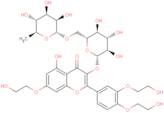
![4H-1-Benzopyran-4-one,2-[3,4-bis(2-hydroxyethoxy)phenyl]-3-[[6-O-(6-deoxy-a-L-mannopyranosyl)-b-D-…](https://static.cymitquimica.com/products/IN/thumb/DA00IC3Y.jpg)
